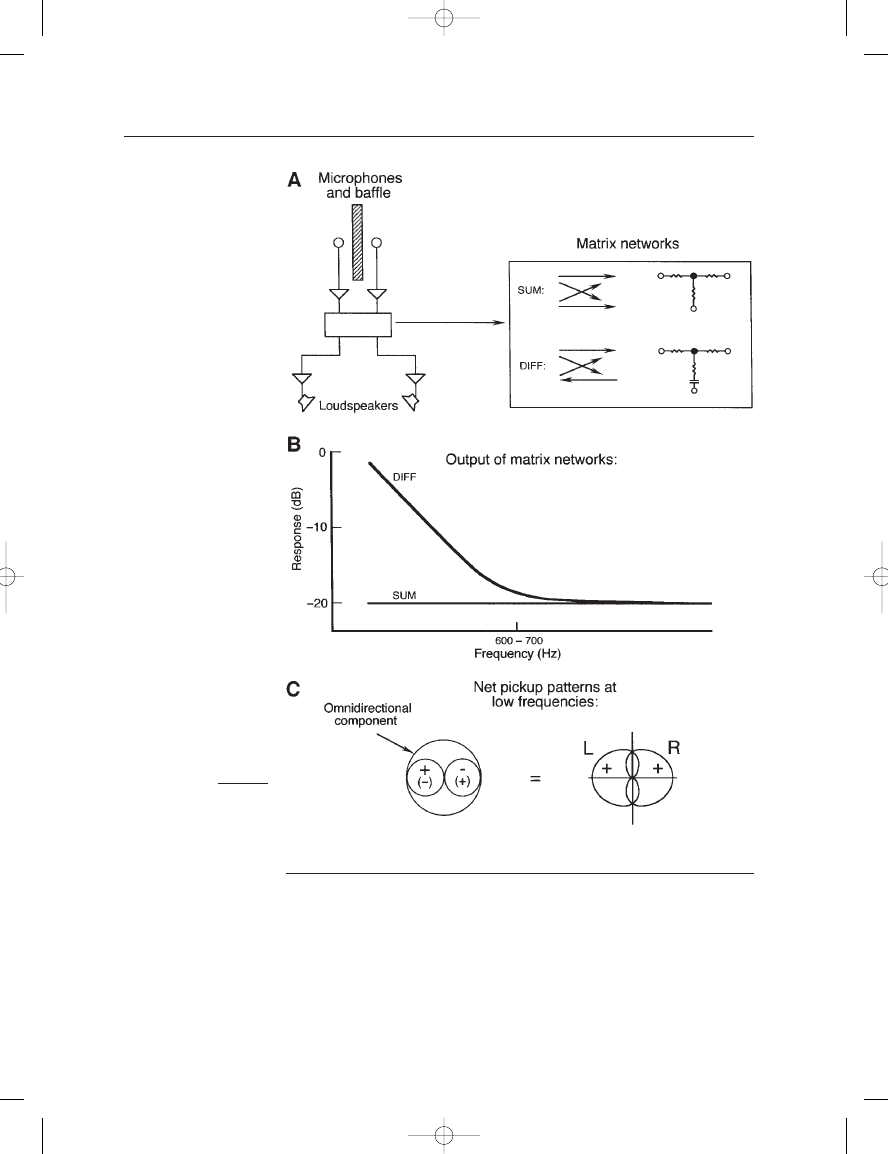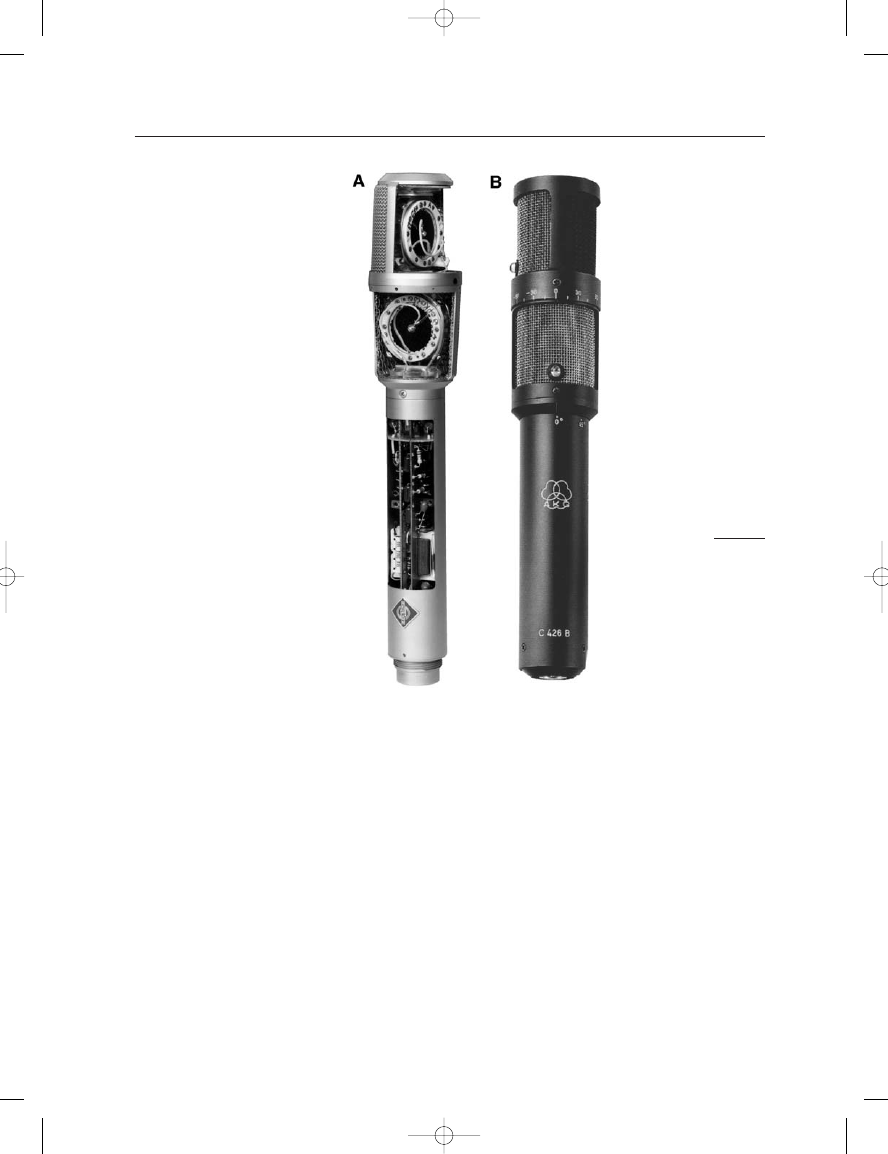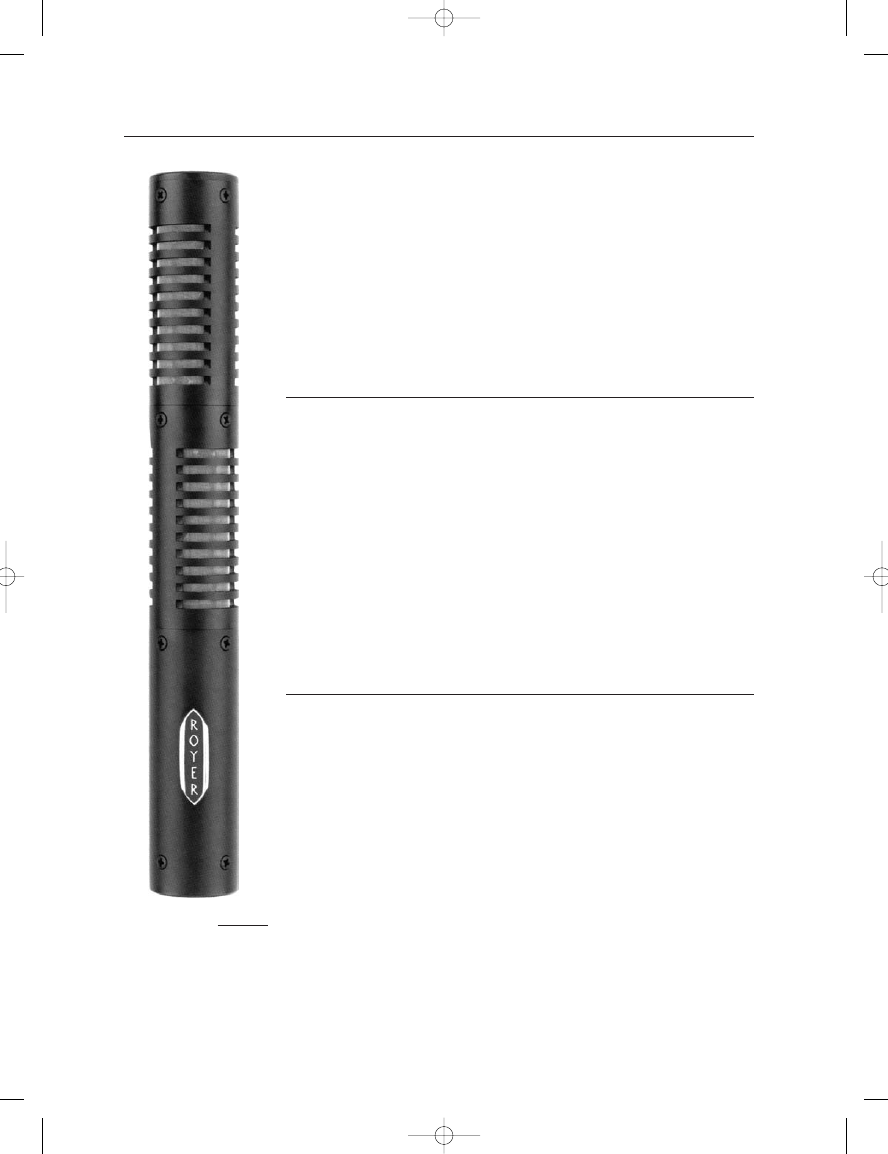ВУЗ: Казахская Национальная Академия Искусств им. Т. Жургенова
Категория: Книга
Дисциплина: Не указана
Добавлен: 03.02.2019
Просмотров: 17306
Скачиваний: 51

11: Basic Stereophonic Recording Techniques
183
microphones of the same type are also used. The microphone of preference
here has been the Neumann M-50, which was discussed in Chapter 3. The
M-50 is essentially an omni microphone at low frequencies, exhibiting a
rising HF response above about 1 kHz and reaching a level 6 dB higher
than at low frequencies. Additionally, the M-50 tends to become more
directional as its on-axis response increases. The array produces a sound
rich in room ambience, along with an abundance of detail at high frequen-
cies. The only difficulty associated with use of the Decca tree is suspending
the three central microphones in a stable manner. A little care is needed,
along with a fairly robust microphone stand.
STEREO LISTENING CONDITIONS
The width of the stereo included listening angle is a subject of consider-
able discussion. Generally, stereo localization is at its most stable when
the loudspeaker–listener angle is moderate. At the same time, however,
the angle must be large enough to convey a realistic performance stage.
Most professional recording engineers would agree that an included
listening angle not exceeding about 45
or 50 is about optimum.
It goes without saying that the listening environment should be fairly
symmetrical about the centerline of the loudspeaker array and that the
listening space be free of noticeable flutter echoes and strong standing
waves. Regarding frequency response of the loudspeakers as they react
with the listening space, the response should be fairly uniform over the
range from about 160 Hz to about 4 kHz. Below 160 Hz a broad rise of
about 2 or 2.5 dB may enhance the presentation, especially at moderate
listening levels. Above about 4 kHz many listeners prefer a uniform
rolloff of the response slightly (no more than 2 or 3 dB). Above all, use
the best loudspeakers that your budget can maintain.
Earg_11.qxd 14/9/04 2:50 PM Page 183

C
H
A
P
T
E
R
1
2
STEREO MICROPHONES
INTRODUCTION
For many applications of coincident stereo or M-S recording, a stereo
microphone may be the best choice. A stereo microphone normally
embodies two closely spaced capsules arrayed one over the other, with
individual pattern adjustment for both capsules and provision for rotat-
ing one of the capsules with respect to the other. This degree of electrical
and mechanical flexibility is necessary in order to cover all aspects and
conditions of coincident recording.
Departing slightly from the notion of capsule coincidence, a number
of dual-microphone mounting techniques have been developed for stereo
recording and are embodied in acoustically appropriate structures. Most
of these are spherical, some purposely head-shaped, while others are
merely some kind of baffle with microphones on opposite sides. While
most of these embodiments work well enough for direct stereo pickup,
some may be more suited to the requirements of binaural recording.
In addition, there are a handful of compound microphones that have
been developed to pick up sound via four or more capsules for purposes
of surround sound pickup; these will be discussed in a later chapter. In
this chapter we will discuss the development of the conventional stereo
microphone and describe several commercial embodiments in detail.
BLUMLEIN’S EARLY EXPERIMENTS
Figure 12–1 shows how Blumlein (1931), using only a pair of omnidi-
rectional microphones, synthesized a pair of cardioid patterns splayed at
90 below about 700 Hz, working in conjunction with a pair of left-
right omnis shadowed by an absorptive baffle that separated them. The
shaded omnis were effective only at frequencies above about 1500 Hz.
This was in fact the first coincident stereo microphone array, and very
likely the first instance of generating a cardioid pickup pattern via the
electrical addition of figure-8 and omnidirectional components.
Earg_12.qxd 14/9/04 2:51 PM Page 184

12: Stereo Microphones
185
ANATOMY OF A STEREO MICROPHONE
The first commercial stereo microphones appeared in the fifties and were
made by Georg Neumann and Schoeps in Germany and AKG Acoustics in
Austria. Two well-known current models are shown in Figure 12–2. The
cutaway detail of the Neumann SM-69 shows the vertical arrangement of
the Braunmühl-Weber dual diaphragm capsule assemblies, with the upper
one free to rotate as required. The AKG Acoustics model C-426 is
equipped with a set of lights to aid in azimuth adjustments in field setup.
FIGURE 12–1
Blumlein’s stereo recording
technique of 1931.
Earg_12.qxd 14/9/04 2:51 PM Page 185

THE MICROPHONE BOOK
186
Figure 12–3 shows the Royer model SF-12 ribbon microphone. The
model consists of a pair of ribbon elements permanently mounted at 90
and dedicated to the Blumlein crossed figure-8 format. It has an XLR
five-pin output receptacle that fans out to a pair of XLR three-pin recep-
tacles for normal console use.
The Josephson C700S is an unusual model that contains an omni
element and two figure-8 elements fixed at angles of zero and 90
.
Because of this, it can perform as a stereo microphone or as a first-order
surround microphone. The three capsule outputs are combined in a flex-
ible control unit to provide five simultaneous signal outputs. The choices
here are all first-order patterns individually ranging from omnidirec-
tional to figure-8. The microphone is shown in Figure 12–4A, and the
signal flow diagram of the controller is shown at B.
Operating in a stereo mode, the system provides an X-Y pair of out-
puts whose patterns can be continuously varied from omni to figure-8
and whose included angle can vary from zero to 180
, with all adjust-
ments made entirely at the control unit. Operating in an M-S mode, a
FIGURE 12–2
Stereo microphones based
on the Braunmühl-Weber
dual diaphragm assembly;
the Neumann model
SM-69 (A); the AKG
Acoustics model 426 (B).
(Photos courtesy of
Neumann/USA and AKG
Acoustics.)
Earg_12.qxd 14/9/04 2:51 PM Page 186

forward-oriented pattern of the user’s choice and a side oriented figure-
eight can be derived.
Operating in a surround mode, or as an adjunct to a larger studio
pickup plan, up to five outputs can be derived. An interesting application
here would be arraying the five outputs at angles of 72
and setting all
patterns roughly to hypercardioid. This could be used to achieve hori-
zontal (azimuthal) plane pickup of ambient sound.
In this regard, the C700S behaves virtually like a Soundfield micro-
phone operating in the horizontal plane. (See Chapter 15 under The
Soundfield Microphone.)
REMOTE CONTROL OF STEREO MICROPHONES
Stereo microphones that use dual diaphragm elements are normally oper-
ated with a remote control electronics unit that provides phantom pow-
ering and switchable pattern control. In most designs, the microphone
capsule assemblies themselves are rotated manually. Many remote control
units provide for Left/Right outputs or Mid/Side outputs, at the choice of
the user. Figure 12–5A shows front and rear photos of the Neumann CU
48i remote control unit, with a circuit diagram shown at B.
As a matter of convenient interface, there are two outputs from the
control unit terminating in conventional XLR-M connectors that accom-
modate P-48 phantom powering from the downstream console. The
microphone assembly itself is fed by a shielded 10-conductor cable which
is available in several interconnecting lengths to adapt to a variety of
installation requirements.
HEADS, SPHERES, AND BAFFLES
At one time, an accurately scaled artificial head containing two pressure
microphones at ear position was thought of only in the context of bin-
aural recording. The basic binaural technique is shown in plan view in
Figure 12–6A, and a typical binaural head is shown at B. Here, the three-
dimensional sound field in the original recording space is accurately
mapped into the listener’s auditory domain via correct time cues and fre-
quency response shaping around the head, along with equalization to
compensate for the secondary signal path between headphones and the
ear drums. Artificial head assemblies are manufactured by, among
others, Georg Neumann GmbH, Knowles Electronics, Brüel & Kjaer,
and Head Acoustics GmbH. In addition to binaural recording, artificial
head systems are widely used in psychological acoustics and evaluation
of performance spaces.
Binaural recordings are intended for headphone reproduction and
do not normally translate well in direct stereo playback, primarily
because of the limited channel separation at low frequencies when
auditioned over stereo loudspeakers. It is possible, however, to convert a
12: Stereo Microphones
187
FIGURE 12–3
Royer model SF-12 ribbon
microphone. (Photo
courtesy of Royer
Laboratories.)
Earg_12.qxd 14/9/04 2:51 PM Page 187